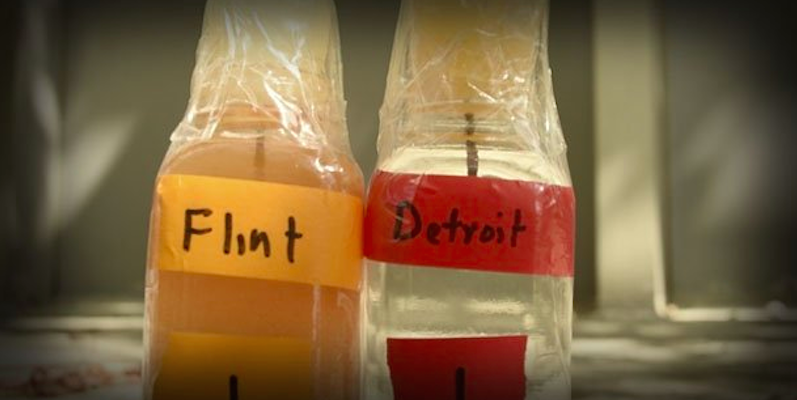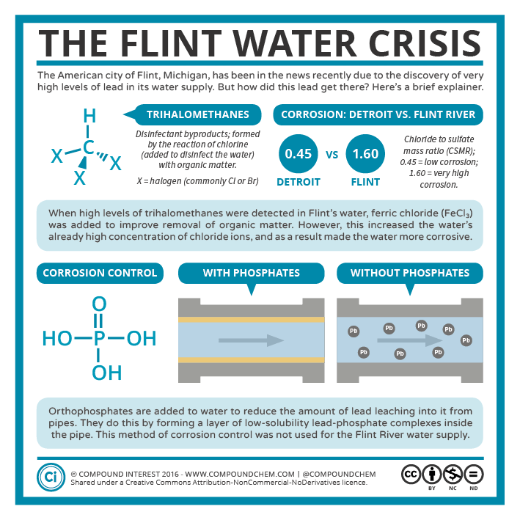
Thanks to strict regulations imposed by the US Environmental and Protection Agency, clean tap water is something Americans take for granted. But such is not the case for the residents of Flint, Michigan. Their water supply is so tainted that President Obama declared a federal state of emergency in Flint releasing up to $5 million USD to help the city combat what is probably one of the biggest public health crisis of recent times.
The chain of events that led to this unprecedented situation began in 2013. In a bid to save money, city officials decided to stop purchasing water from Detroit and instead switch to a new water authority. This move they claimed would save the financially-strapped city millions of dollars. Given that the new water authority planned to bring in water from Lake Huron, the same source as used by Detroit, it appeared to be a smart move.
The plan, however, had one major flaw. While the contract with Detroit ended in 2014, the pipeline that would bring water from the new supplier was not expected to be ready until 2016. But the officials were not concerned. They had the perfect interim solution. They would save even more money by using water from the nearby Flint River. Though the river has a storied history because of past use as a dumping ground for chemicals and trash, it has since been cleaned up and, therefore, deemed 'safe' to use for the city's water supply.

The switch, which was made in April 2014 was declared a "historic moment" by the city's former Mayor Dayne Walling. The State Department of Environmental Quality proclaimed that the water quality was so good that residents would not notice the difference.
But they were wrong. Almost immediately, residents began complaining about the water's foul taste and appearance. But city officials kept insisting the water was perfectly fine and safe, and the Mayor was even quoted saying "I think people are wasting their precious money buying bottled water."
Over the next few months, there would be numerous other safety concerns, including a citywide advisory to boil the water after e.coli bacteria were detected. Another red flag came in October 2014 when General Motors refused to use the water because it was rusting car parts. The city immediately agreed to allow the car manufacturer to tap into a different water line. However, they did nothing for the residents, because as they kept asserting, there was nothing wrong with the water!
It took another year, and numerous protests and expert opinions before Michigan Governor Rick Snyder finally stepped in and announced that the state would purchase water filters for schools. He also asked experts to check for the levels of lead in school water supplies. They were so high that the following week, the governor allocated $6 million USD to enable Flint to switch back to water from Detroit.

But that has not helped the issue. That's because the lead was not in the Flint River water, but being leached by the pipes that it flows through. Turns out that like most rivers, the water in the Flint River has a high concentration of chloride ions thanks to the run-off from large amounts of salt used to de-ice roads during winter. While safe for humans they are highly corrosive, which is why General Motors experienced the rusting. Hence, as the water flowed through the pipes, many of which were built before the use of lead was banned, it ate away at the coating, enabling the harmful lead to leach in. It is therefore no wonder that three months after the switch, authorities continue to advise residents to use bottled water for all their needs.
What's ironic is that a 2011 study had found that adding an anti-corrosive agent that would have cost a mere $100 USD a day would have eliminated about 90% of the current issues. Whether the officials forgot or just didn't want to add the chemical is currently under investigation as is the question of who is to blame for this catastrophe.
Meanwhile, the residents of Flint are left suffering the consequences of the poor decisions. In addition to dealing with the high lead levels in their tap water, they are also concerned about their health. A study published in the American Journal of Public Health in December revealed that the number of children with dangerously high lead levels in their blood has doubled since the water supply was switched. This is extremely worrisome given that early lead exposure is detrimental to young children whose neurological systems are still forming. It is known to result in lower IQ, behavioral issues and developmental delays.

Though the damage cannot be reversed, health workers are trying to do everything they can to mitigate the effects. This includes educating parents about feeding young kids a diet rich in iron, calcium, and vitamin C - All known to fend off the harmful impact of lead exposure. They are also working with teachers to identify developmental issues earlier on so that affected kids can be channeled into special programs.
Even if all the health damage caused thus far is controlled, there is still the question of how the problem will be solved permanently. While Michigan Governor Rick Synder accepted responsibility for the debacle in his January 19 State of the State address and promised to fix things, it is easier said than done.
According to experts about half of Flint's residents are receiving water via corroded lead pipes. While changing water filters regularly can mitigate the problem, the only way to fix it is by replacing the pipes which according to Flint's new mayor will cost $1.5 billion USD - Money that will be hard to come by in this cash-strapped city!
Resources: miive.com, usatoday.com,cnn.com,nbc.com,abc.com,freep.com,fixthemitten.com